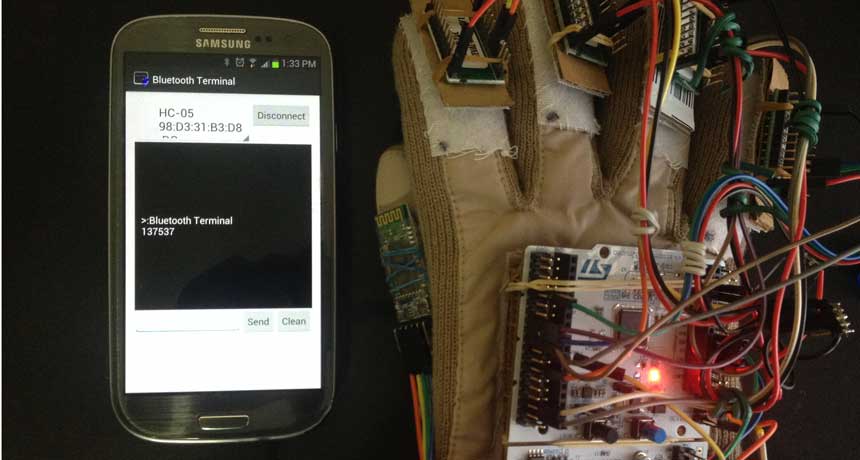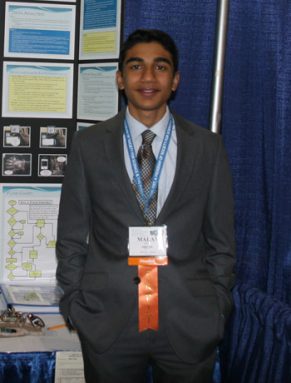Computing: Swapping a glove for the keyboard
Sensor-laden glove can ‘type’ anywhere, or even get computers to ‘read’ sign language

The small computer and sensors on this prototype glove read finger motions and translate them into data that can be displayed on a laptop or other device nearby.
Malav Shah
By Sid Perkins
PITTSBURGH, Pa. — Today people use keyboards and mice to enter data into computers. They play harps and guitars by strumming strings. They play violins and cellos with a bow. But one day soon, a high-tech glove might be able to stand in for any or all of these devices and instruments, says Malav Shah.

A computer’s keyboard works much the same way that an old-fashioned typewriter does. A person moves a finger to a particular location and then presses down on a key that corresponds to some letter, number or symbol. Thanks to modern electronics, using a keyboard requires less force than banging on a typewriter. But it’s possible for engineers to go even further, Malav says. He envisions a day when gloves studded with motion-detecting sensors could make keyboards obsolete.
Malav’s prototype glove employs accelerometers. They are the same sort of motion-detecting sensors found in many smartphones and other high-tech devices. The teen’s first version used four of the motion sensors, each of which costs about $25. They monitor the movement of individual fingers in all three dimensions — back and forth, side to side, and up and down. These sensors send data detailing those motions to a $10 mini-computer attached to the glove. A simple computer program translates the finger motions into individual letters. The computer then broadcasts those data wirelessly for display on a laptop or other device nearby.
Malav’s “virtual keyboard” could be modified to interpret any sort of finger motions. A user wouldn’t have to type on a placemat-like map of letters and numbers, he notes. In theory, you could type on any surface. Or, if a user couldn’t move her arms or hands, you still could train the device to interpret her finger movements alone.

And there’s no reason to stop with keystrokes and finger-spelling, says Malav. By adding sensors to measure arm motions, he says, engineers could design a glove that interprets broader gestures used to form whole words and phrases in ASL. Or, doctors could use a version of the glove to measure finger motions in patients with injuries. That way, they could better monitor an individual’s recovery.
A glove with a large number of sensors might even be programmed to interpret the often-delicate finger movements needed to play a musical instrument. Examples, Malav says, could include a guitar, piano or harp. And instead of playing an “air guitar” to mimic the music blasting from a stereo, you could actually make music by simply “strumming” the air. Rock on!
Power Words
(for more about Power Words, click here)
accelerometer An instrument for measuring vibrations or a change in the rate of movement. These sensors typically can measure movement changes in all three dimensions (front-to-back, side-to-side and up-and-down).
American Sign Language A way of communicating using hand shapes and body movements.
electronics Devices that are powered by electricity but whose properties are controlled by the semiconductors or other circuitry that channel or gate the movement of electric charges.
engineer A person who uses science to solve problems. As a verb, to engineer means to design a device, material or process that will solve some problem or unmet need.
engineering The field of research that uses math and science to solve practical problems.
force Some outside influence that can change the motion of a body, hold bodies close to one another, or produce motion or stress in a stationary body.
prototype A first or early model of some device, system or product that still needs to be perfected.
sensor A device that picks up information on physical or chemical conditions — such as temperature, barometric pressure, salinity, humidity, pH, light intensity or radiation — and stores or broadcasts that information. Scientists and engineers often rely on sensors to inform them of conditions that may change over time or that exist far from where a researcher can measure them directly.
simulate To deceive in some way by imitating the form or function of something. A simulated dietary fat, for instance, may deceive the mouth that it has tasted a real fat because it has the same feel on the tongue — without having any calories. A simulated sense of touch may fool the brain into thinking a finger has touched something even though a hand may no longer exists and has been replaced by a synthetic limb. (in computing) To try and imitate the conditions, functions or appearance of something. Computer programs that do this are referred to as simulations.
smartphone A cell (or mobile) phone that can perform a host of functions, including search for information on the Internet.
Society for Science and the Public (or SSP) A nonprofit organization created in 1921 and based in Washington, D.C. Since its founding, SSP has been not only promoting public engagement in scientific research but also the public understanding of science. It created and continues to run three renowned science competitions, including the Intel International Science and Engineering Fair (initially launched in 1950). SSP also publishes award-winning journalism in Science News (launched in 1922) and Science News for Students (created in 2003).
virtual Being almost like something. An object or concept that is virtually real would be almost true or real — but not quite. The term often is used to refer to something that has been modeled — by or accomplished by — a computer using numbers, not by using real-world parts. So a virtual motor would be one that could be seen on a computer screen and tested by computer programming (but it wouldn’t be a three-dimensional device made from metal).







